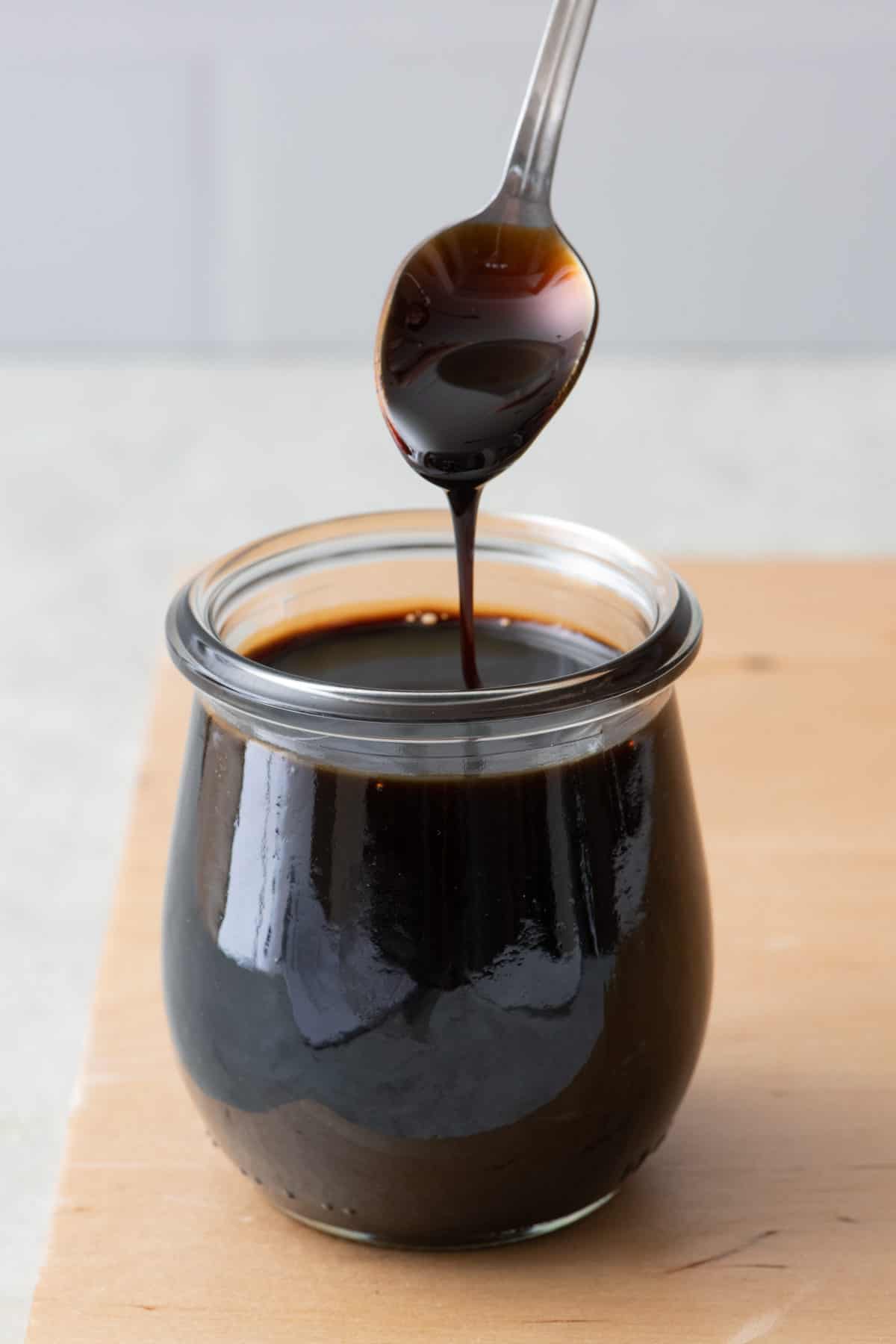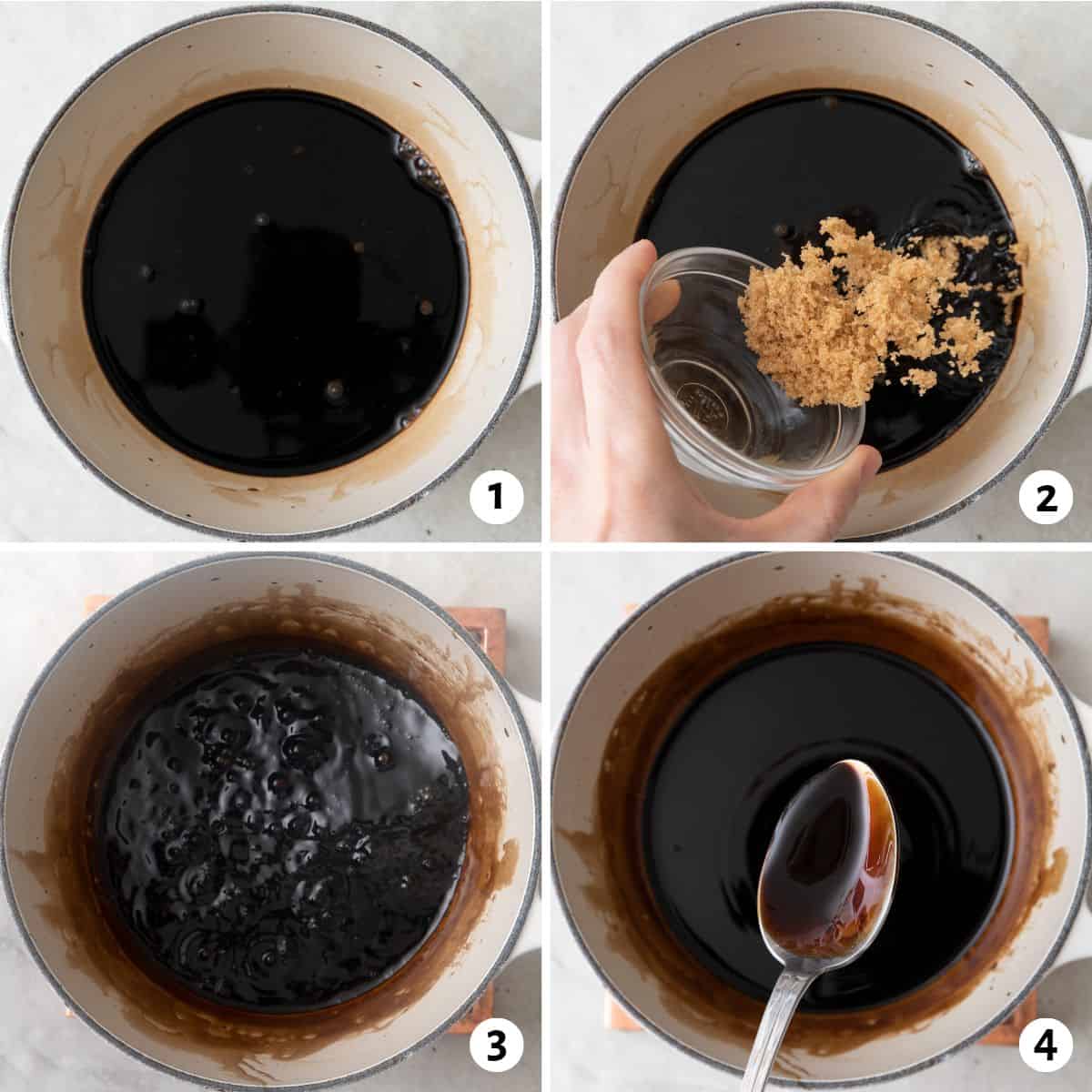This post may contain affiliate links. Please read our disclosure policy.
Learn how to make balsamic glaze right in your own kitchen. It can be used as a dressing, marinade, dip, or as a finishing sauce to complete a bruschetta or even pizza. With just a few simple ingredients and easy steps, you can create a rich, sweet, and tangy balsamic reduction that will take your dishes to a new level of deliciousness.

Table of Contents
You may have heard balsamic glaze being referred to as balsamic reduction, and that’s indeed a fitting description. It’s basically balsamic vinegar reduced to a thick, syrupy consistency. In this simple step-by-step guide, I’ll teach you how to make the best balsamic glaze for bruschetta, caprese skewers, salad, and more!
Why learn how to make balsamic sauce
- Simple ingredients. This recipe requires two basic pantry ingredients that you likely already have on hand. And by making a batch at home, you have full control over the quality of the ingredients used.
- Budget-friendly. Homemade balsamic glaze can be a more cost-effective option compared to store-bought alternatives. Prepare a large batch for a fraction of the price that you would pay at the store.
- Easy way to elevate any dish. This balsamic reduction has the perfect balance of flavors that can take any dish from blah to mouthwatering and delicious.
Ingredients to make balsamic glaze
- Balsamic vinegar: This is the main ingredient in balsamic glaze and provides that distinct tangy and slightly sweet flavor. As it simmers and reduces, the concentrated flavors develop a rich taste.
- Brown sugar: Though this is optional, brown sugar balances the overall flavor of the balsamic reduction. It also adds a subtle caramel note and helps to thicken the glaze.

How to make balsamic glaze
- Pour the balsamic vinegar into a medium saucepan.
- Add brown sugar to the vinegar and bring to a gentle boil.
- Reduce the heat and allow the vinegar to simmer gently, stirring occasionally.
- Once the glaze has reached your desired consistency, remove the saucepan from the heat and let it cool for a few minutes.

Tips for making the best balsamic glaze
- Heat control. When simmering the balsamic vinegar, it’s important to keep an eye on the heat to prevent it from boiling over or burning. This gentle simmering process allows the vinegar to gradually reduce and thicken without burning.
- Test for consistency. Dip a spoon into the saucepan and lift it out. The glaze should coat the back of the spoon and slowly drip off. If it’s too thin, continue simmering for a few more minutes. If too thick, you can add a splash of water or more balsamic vinegar to thin it out.
- Adjust for sweetness. The brown sugar is optional but provides a touch of sweetness to balance the tangy acidity of the balsamic vinegar. You can leave it out or adjust the amount to suit your taste preference.
- Experiment with flavors. This is a basic tutorial on how to make balsamic reduction, but you can get creative and experiment with different flavors. Infuse the glaze during simmering with herbs like rosemary or thyme, or add a touch of honey for extra sweetness.
recipes to make with balsamic reduction
- Caprese Skewers
- Tomato Caprese Salad
- Caprese Pasta Salad
- Deli Charcuterie Skewers
- Strawberry Spinach Salad

How to store & reheat balsamic glaze
Transfer the glaze to a clean, airtight container or mason jar and let it cool completely. As it cools, it will thicken even more. It’s best to pour it into a container while it’s still warm. If it has cooled off too much and has become too thick to transfer, simply reheat just enough to make it pourable.
Store the balsamic reduction in the refrigerator.
How long will balsamic glaze LAST IN THE FRIDGE?
The balsamic glaze will last for up to 3 months.
Can I freeze balsamic sauce?
I do not recommend freezing balsamic glaze as the freezing and thawing process will alter the texture and consistency of the glaze.
Frequently Asked Questions
Yes, you can buy balsamic glaze at most grocery stores. It is typically available in the condiment section or the vinegar aisle.
Because of the thick consistency, it can be a little tricky to add balsamic glaze to dishes. Here are some ways to serve balsamic glaze:
Drizzle: Use a spoon or a squeeze bottle to drizzle directly over the dish, creating thin lines or zigzag patterns across the surface.
By the spoon: Use a spoon to strategically place small dollops of glaze into certain pockets in your food.
Brushing: For meats, poultry, or roasted vegetables, use a pastry brush to evenly apply the glaze.
Dipping: Serve balsamic glaze in a small ramekin as a dipping sauce and pair with bread, cheese, or vegetables.
Balsamic glaze is not the same without balsamic vinegar. However, you can experiment with different types of vinegar for variations in flavor. Keep in mind that the taste and consistency of the glaze may differ from traditional balsamic glaze.

With its rich, sweet, and tangy flavors, this versatile condiment adds depth of flavor to any dish. By following these simple steps, you will learn how to make a balsamic reduction for pizza, salad, or your favorite meats.
More cooking tutorials:
- How to Make Pomegranate Molasses
- How to Make Yogurt
- How to Make Ashta
- How to Make Spicy Mayo
- How to Make Cashew Butter
- How to Make Apple Butter
- How to Make Jam
- How to Roast Red Peppers
- How to Make Gravy
- How to Make Chimichurri
If you found this tutorial for How to Make Balsamic Glaze helpful or if you try any recipe on Feel Good Foodie, then don’t forget to rate the recipe and leave a comment below! It helps others who are thinking of trying out this tutorial and we would love to hear about your experience. And if you snapped some shots, share it on Instagram so we can repost on Stories!

How to Make Balsamic Glaze
Ingredients
- 2 cups balsamic vinegar
- ¼ cup brown sugar optional, for sweetness
Instructions
- Pour the balsamic vinegar (and brown sugar if using) into a medium saucepan over medium heat and bring the balsamic vinegar to a gentle boil.
- Reduce the heat to medium-low and allow the vinegar to simmer slowly for about 15-20 minutes, stirring occasionally with a heat resistant spoon. As it simmers, the balsamic vinegar will reduce and thicken, forming a syrupy consistency. Keep an eye on it to prevent it from burning or boiling over.
- To test the consistency of the glaze, dip the spoon into the saucepan and lift it out. The glaze should coat the back of the spoon and slowly drip off. If it’s too thin, continue simmering for a few more minutes. If it’s too thick, you can add a splash of water or more balsamic vinegar to thin it out.
- Once the glaze has reached your desired consistency, remove the saucepan from the heat and let it cool for a few minutes.
- Transfer the glaze to a clean, airtight container and let it cool completely. As it cools, it will thicken slightly more. Makes ½ cup.
Equipment
Notes
Nutrition
Nutrition information provided is an estimate. It will vary based on cooking method and specific ingredients used.






If I simmered too long and it is too thick, how would I thin it?